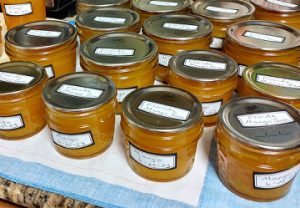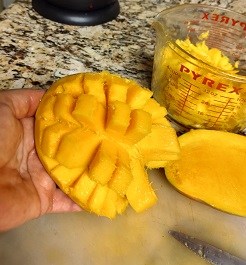Thinking about all those Florida mangoes, what is your favorite way to enjoy fresh Florida mangoes? Fresh cut, mango salsa, chutney, mango jam, mango butter, smoothies? In my opinion, mangoes are best when fully ripe and fresh from the tree, eaten over the kitchen sink.
Most of the early season mangoes are finished producing by the end of July. However, there are a few late-season varieties which may still be producing well into early September or even into October. Using the handy chart at the end of the UF/IFAS EDIS (University of Florida’s Institute of Food and Agricultural Sciences Electronic Data Information Source) publication, “Mango Growing in the Florida Home Landscape“, you may choose more than one variety of mango tree to grow based on the month their fruit ripens. This could prolong your harvest through the whole summer.
Also in the charts at the end of the above noted publication, the fruit weight is listed. There are mangoes which may weigh 28, 30 and even 40 ounces each! That could easily be one batch of mango jam per fruit.
What Can I Do With All These Mangoes?
If you have a mature mango tree, there really is no way to use them all yourself. So many mangoes are wasted to invading squirrels and fruit dropping to the ground. Some folks will set up a sign in their yard advertising, “Mangoes for Sale, $1 each!” That’s a financially savvy way to share excess fruit and pick up some cash for fruit tree fertilizer. If you are shopping from the roadside, you may get to try new varieties and to talk to folks who have grown Florida mangoes successfully.
However, when I have too many mangoes, I make mango jam and mango butter. And stock my freezer for winter with fresh cubes of golden goodness in quart-sized freezer bags. Mango Crisp for Thanksgiving dessert is a show-stopper!

Mango Jam
Ingredients:
- 4 cups cubed mango
- 2 tablespoons lemon or lime juice
- 1 box powdered fruit pectin
- 5 1/2 cups sugar
- Optional: 1 tablespoon freshly minced ginger
Instructions:
- Slice the mangoes into small cubes, measuring exactly 4 cups. Place these into a large saucepot with the lime juice and minced fresh ginger (if using).
- Cook till tender.
- Mash the fruit- smooth or chunky is up to you.
- Return to a boil.
- In a separate batter-bowl, mix the sugar and pectin. Add the sugar-pectin mixture to the bubbling fruit and stir continually till it comes to a rolling boil while stirring.
- Boil and stir for exactly 2 minutes.
- Remove from heat and either let cool and freeze the jam or ladle into hot, sterilized jars for water-bath-canning.
- Process the jars, with lids on, in a water-bath-canner for 10 minutes.
NOTE: Use home-canned jam within about 1 year. These jars make great friendship gifts.
What is Mango Butter?
Mango butter is a “fruit butter”, smooth and soft. Fruit butters have half the sugar of jam and do not require pectin. Once in a while a fruit butter batch may not “set” or gel. This is perfectly fine. Think of a fruit butter as a cross between apple sauce and apple butter and use it in the same ways. I do not spice my mango butter so it is golden-yellow and very smooth. If a batch of mango butter comes out runny, it makes a great sauce baked over chicken or pork. Or it may be added to a barbeque sauce with great success.
Mango Butter Recipe

Ingredients:
- 6 cups finely cubed mango
- 2 cups Sugar
- 2 tablespoons fresh lime juice
Instructions:
- Cook the mango and lime juice in a large saucepot till bubbly and fruit is very soft.
- Mash the fruit or use an immersion blender to completely puree all the bits of mango in the pot.
- Continue boiling till slightly thickened.
- Ladle into hot, sterilized pint jars and water-bath can for 10 minutes. Or cool and freeze.
NOTE: if using mangoes which are firm and not quite ripe, you may need to add more sugar.
The go-to website for all questions regarding home canning is the USDA’s “Complete Guide To Home Canning, Guide 2: Selecting, Preparing, and Canning Fruit and Fruit Products”
To learn more about growing a mango tree in Florida, the University of Florida’s Institute of Food and Agricultural Sciences Electronic Data Information Source (UF/IFAS EDIS) publication, “Mango Growing in the Florida Home Landscape” is a great resource to have on hand. It can help you choose your variety for fruiting month or size, or productivity of the tree.
Source: UF/IFAS Pest Alert
Note: All images and contents are the property of UF/IFAS.



